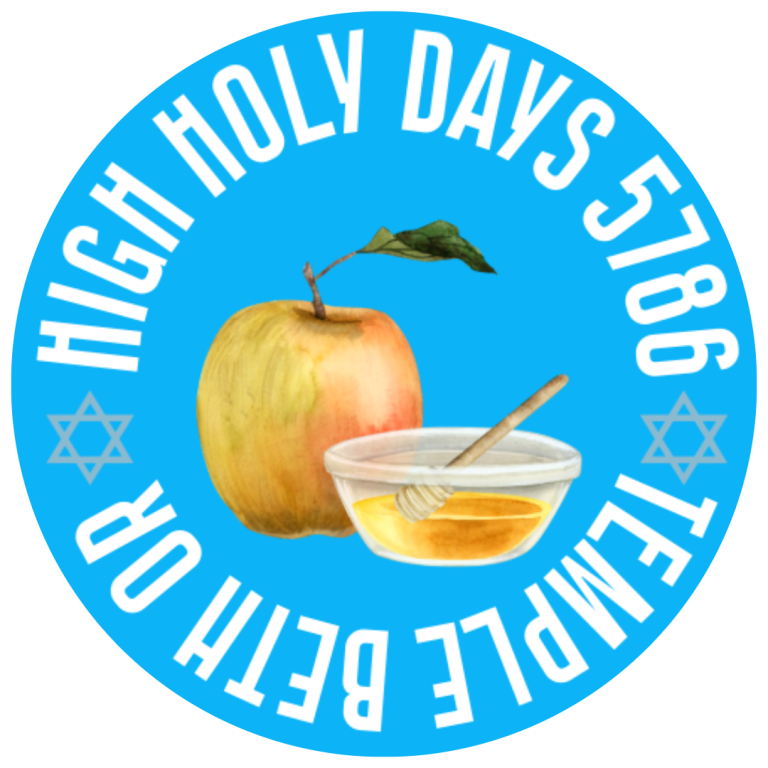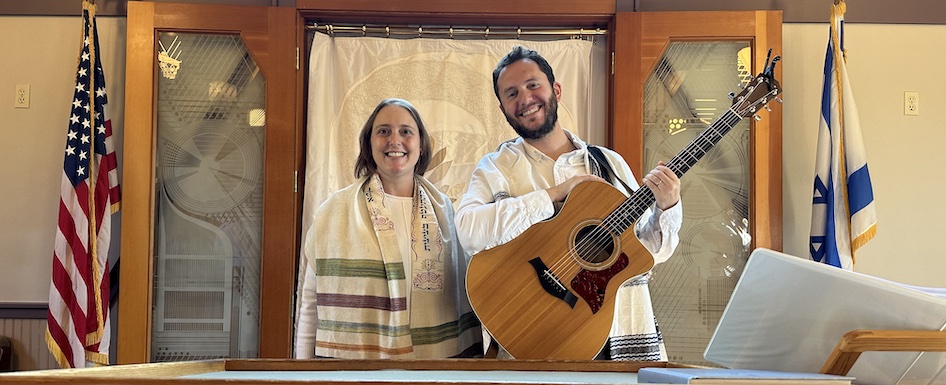
Member Attendance & Registration
- Members in good standing will receive tickets by mail. Members do not need to register to attend services, but do need to sign up for Rosh HaShanah children’s programming and optional catered lunch.
- If you have not received tickets and/or you find your Temple dues are a concern, please contact a member of the finance committee to confidentially help bring your membership back into good standing so you can receive your tickets.
Guest Attendance & Registration
- All attendees must register to attend in person. The deadline to register to attend services in person is September 16.
- Everyone is welcome to attend our services, and pre-registration is required for in-person participation. We ask non-members for a $180 donation for an individual or $360 per family in order to share in the costs of maintaining Jewish resources in this community. These donations are for the whole High Holy Day season, however many events and services you are able to attend. These are suggested donation amounts; please do not let cost affect your decision to join us.
Online Services
Online attendance for members and visitors is via self registration. There is no need to look for a missing Zoom link sent from TBO weeks before the service. You can register right up until, or even after, the beginning of services — but if you register in advance Zoom will send you reminders! Access service links here.
Family Services
A special Shabbat Shuva Tot Shabbat will be held on Saturday, September 27. A family Erev Yom Kippur service will be held on Wednesday, October 1. Please see the schedule for details.
Yizkor Service of Remembrance
Please call the office at 425-259-7125 if you would like to add a name to your family’s Yizkor list. All names on your family’s list will be printed in the brochure. Names of immediate family members will be read aloud during the Yizkor Service. Deadline for adding/changing the printed list is September 8, 2025.
Accessibility
Unity in Lynnwood is ADA accessible, with a ramp at the main entrance and handicap accessible restroom stalls located on the main floor. The service venue at our Rosh HaShanah Service Venue is also accessible. Please contact the office if you need accessibility arrangements or additional details.
High Holy Day Donations
As the High Holy Days are a traditional time to make donations, may we suggest donations in support of these Temple Beth Or funds: General Fund, the Wexler Family Music Fund, Religious School Scholarship Fund, Torah Repair Fund, and/or the Tzedakah Fund to help organizations and individuals in need. Many thanks to Eldon and Carolyn Wexler for establishing and seeding the Wexler Family Music Fund which helps support hiring a musical leader to enhance our High Holy Days services. Donations to the Wexler Family Music Fund are matched dollar for dollar by the Wexler family.
Fragrance-free
We ask your consideration for the many individuals who are sensitive to scented personal products such as lotions, perfumes, and colognes. During the High Holy Days our sanctuary is generally crowded and we request that you refrain from wearing these scented products.
HHD Food Bank Collection
Once again this year Temple Beth Or is helping our local Volunteers of America Food Bank as part of the High Holy Days Food Drive. The Torah and Jewish tradition command that we feed the hungry and help eradicate hunger from our society. While hygiene items and non-perishable foods are always welcome, a monetary donation either as a check (made out to Volunteers of America Western Washington) or food store gift cards would also be greatly appreciated, as it allows the Food Bank to purchase items most needed, including perishables. Direct donations can be made at voaww.org/donate. Other ways to support the community include volunteering at a community garden that donates product to food banks, or volunteering at the food bank. For more information please contact volunteer.voaww.org.
Donations can be brought to Erev Yom Kippur or Yom Kippur Morning Service. Volunteers will be available in the parking lot near the building entrance to collect donations at a member’s car.
Parking
Parking is available in the lot at Unity in Lynnwood. There is no street parking available, so we encourage you to carpool to ensure there is enough parking for all attendees. On Yom Kippur morning, we will also run a shuttle to offsite parking at the Fred Meyer across Alderwood Mall Parkway to ensure adequate parking given the additional vehicles that will be onsite on a weekday. If the Unity lot is full, park near the Fred Meyer Garden center (behind the gas station) where you will be able to meet the shuttle.
Soundtrack Preview
Rabbi Kort and Music Leader Steven Chaitman have created a Spotify playlist highlighting music that will be featured throughout our HHD celebrations. Listen at: https://tinyurl.com/TBO-HHD-Spotify
Member Participation Opportunities
We hope that you will take some extra time to consider service participation. It is a tradition at Temple Beth Or to include as many members as possible in each aspect of the services. Your participation brings greater depth to our services. There are many opportunities to be involved, including singing and English readings
Do you like to sing? Join our High Holy Day Singers! With the High Holy Days just around the corner, it is time to get your voice warmed up and join our group of community singers. No experience is necessary. It’s a great way to participate in the High Holy Days, connect with other members and get an opportunity to work closely with our High Holy Days music leader, Steven Chaitman. Music and recordings will be available in advance. You can choose which of the songs you want to sing or go all in and do them all. Instrumental musicians who can read music or chords are welcome to participate too. We have two rehearsals, one for each holy day. Please contact the office if you have any questions and/or are interested in becoming a member of the High Holy Days Singers and Musicians.
Calling All Shofar Blowers: Please bring your shofar and join our shofar chorus for t’kiah g’dolah (the big concluding shofar blast) at our Rosh HaShanah Morning Service and our Neilah, Yom Kippur Concluding Service at Unity in Lynnwood.
About the High Holy Days

Rosh HaShanah
Rosh HaShanah (“Head of the Year”) is observed on the first day of the month of Tishrei. It marks the beginning of the High Holy Days, which culminates on Yom Kippur. The customs and symbols of Rosh HaShanah reflect the holiday’s emphasis on both happiness and humility. On Rosh HaShanah, we sound the shofar, use round challah, and eat apples and honey for a sweet new year.
Selichot (“forgiveness”) is the candlelight service marking the Jewish week preceding Rosh HaShanah. Held after sundown on Saturday, this service begins our cheshbon nefesh (“accounting of the soul”) as part of t’shuvah (“return”) to our truest selves. We begin with dessert, Havdalah and a worship service; then close the evening in quiet reflection as the parokhet (ark curtain) and Torah covers are prepared for the coming High Holy Days.
Tashlich (“casting off”) is a symbolic dispersal of our errors to the winds and the sea, after we have begun the process of t’shuvah. Our Tashlich service is held at a local lake or river on Rosh HaShanah afternoon.
Yom Kippur
Yom Kippur (“Day of Atonement”) is the holiest day in the Jewish calendar. In three separate passages, the Torah states, “the tenth day of the seventh month is the Day of Atonement. It shall be a sacred occasion for you: You shall practice self-denial.” (Leviticus 23:27). We fulfill this commandment by fasting, which also enables us to put aside our physical desires and to concentrate on our spiritual needs through prayer, repentance and self-improvement. It is customary in the days before Yom Kippur to seek out friends and family whom we have wronged and ask for their forgiveness.
The Shabbat Shuvah (“The Shabbat of Return”) Service, occurs on the Saturday between Rosh Hashanah and Yom Kippur and is considered to be a time of reflection leading up to the Day of Atonement.
Yom Kippur concludes with a Yizkor (“remembrance”) Memorial Service, where the names of members’ immediate family are read aloud.
